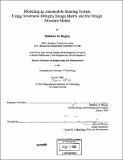Modeling an automobile steering system using Axiomatic Design's Design Matrix and the Design Structure Matrix
Author(s)
Bagley, Matthew R., 1966-
DownloadFull printable version (15.41Mb)
Other Contributors
System Design and Management Program.
Advisor
Daniel Whitney.
Terms of use
Metadata
Show full item recordAbstract
The automobile steering system can be thought of as a system within a system. The steering system has clear functions and requirements as well as many interrelated components and subsystems including the front tires, wheels, front suspension, steering gear, intermediate shaft, column and steering wheel. System decomposition is an important aspect of this system analysis. The scope of this thesis is the steering system and steering attributes of a particular new model program code named UXXX. An important element of this research is a case study where an error state called Nibble was discovered late in the program. The attempted resolution of the concern caused much turmoil and drove higher component costs, engineering costs, launch delays, warranty costs and decreased customer satisfaction. The main objective of this work was to execute good system analysis to understand key interactions within the system and to provide documentation and knowledge transfer of key discoveries. A requirement based Design Structure Matrix (DSM) was used as the primary methodology for system analysis. In order to construct the DSMs, Axiomatic Design's Design Matrix (DM) was used to develop Functional Requirements (FRs) and Design Parameters (DPs). The requirements based DSM was derived from the DM. DSMs were created from requirements based interactions, spatial interactions and Nibble relationships (Design Parameters influencing Nibble). Herein outlines an approach for synthesizing functional requirements to create a quality Design Matrix and then transform into a DSM. One key discovery is in the development of FRs using a left-to-right and then a right-to-left approach followed by synthesis. Another important development is a matrix comparison (cont.) method where matrices of different types of interactions are compared through matrix addition. Discussion of key questions from the case are presented as well as conclusions, recommendations and proposed future work.
Description
Thesis (S.M.)--Massachusetts Institute of Technology, System Design & Management Program, 2005. Includes bibliographical references (p. 128-129).
Date issued
2005Department
System Design and Management Program.Publisher
Massachusetts Institute of Technology
Keywords
System Design and Management Program.